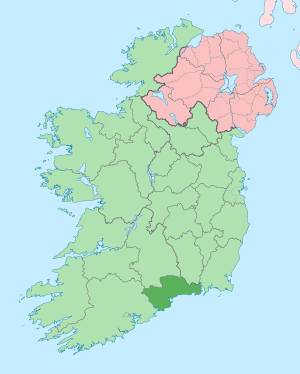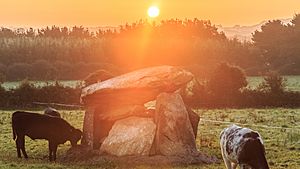County Waterford facts for kids
Quick facts for kids
County Waterford
Contae Phort Láirge
|
||
|---|---|---|
|
||
| Nickname(s):
The Déise
|
||
| Motto(s):
Déisi oc Declán co Bráth (Old Irish)
"May the Déise remain with Declan forever" |
||
 |
||
| Country | Ireland | |
| Province | Munster | |
| Region | Southern | |
| Established | 1207 | |
| County town | Waterford | |
| Area | ||
| • Total | 1,858 km2 (717 sq mi) | |
| Area rank | 20th | |
| Highest elevation | 792 m (2,598 ft) | |
| Population
(2022)
|
||
| • Total | 127,363 | |
| • Rank | 20th | |
| • Density | 68.548/km2 (177.54/sq mi) | |
| Time zone | UTC±0 (WET) | |
| • Summer (DST) | UTC+1 (IST) | |
| Eircode routing keys |
E32, E91, X35, X42, X91 (primarily)
|
|
| Telephone area codes | 051, 058 (primarily) | |
| Vehicle index mark code |
W (since 2014) WD (1987–2013) |
|
County Waterford (Irish: Contae Phort Láirge) is a county in Ireland. It is in the province of Munster and is part of the Southern Region. It is named after the city of Waterford. Waterford City and County Council is the local authority for the county. The population of the county at large, including the city, was 127,363 according to the 2022 census. The county is based on the historic Gaelic territory of the Déise. There is an Irish-speaking area, Gaeltacht na nDéise, in the southwest of the county.
Geography and subdivisions
County Waterford has two mountain ranges, the Knockmealdown Mountains and the Comeragh Mountains. The highest point in the county is Knockmealdown, at 794 m (2,605 ft). It also has many rivers, including Ireland's third-longest river, the River Suir (184 km (114 mi)); and Ireland's fourth-longest river, the Munster Blackwater (168 km (104 mi)). There are over 30 beaches along Waterford's volcanic coastline. A large stretch of this coastline, known as the Copper Coast, has been designated as a UNESCO Geopark, a place of great geological importance. To the west of Dungarvan is the Déise Gaeltacht, an Irish-speaking region comprising the areas of Ring, County Waterford and Old Parish.
Waterford City is the county seat; prior to the merger of the 2 Waterford authorities in June 2014 Dungarvan was the county seat for Waterford County Council.
Baronies
There are eight historic baronies in the county: Coshmore and Coshbride, Decies-within-Drum, Decies-without-Drum, Gaultiere, Glenahiry, Middlethird, Upperthird and Waterford City.
Largest towns
| Historical population | ||
|---|---|---|
| Year | Pop. | ±% |
| 1600 | 14,456 | — |
| 1610 | 9,887 | −31.6% |
| 1653 | 13,136 | +32.9% |
| 1659 | 13,286 | +1.1% |
| 1821 | 76,103 | +472.8% |
| 1831 | 85,217 | +12.0% |
| 1841 | 196,187 | +130.2% |
| 1851 | 164,035 | −16.4% |
| 1861 | 134,252 | −18.2% |
| 1871 | 123,310 | −8.2% |
| 1881 | 112,768 | −8.5% |
| 1891 | 98,251 | −12.9% |
| 1901 | 87,187 | −11.3% |
| 1911 | 83,966 | −3.7% |
| 1926 | 78,562 | −6.4% |
| 1936 | 77,614 | −1.2% |
| 1946 | 76,108 | −1.9% |
| 1951 | 75,061 | −1.4% |
| 1956 | 74,031 | −1.4% |
| 1961 | 71,439 | −3.5% |
| 1966 | 73,080 | +2.3% |
| 1971 | 77,315 | +5.8% |
| 1979 | 87,278 | +12.9% |
| 1981 | 88,591 | +1.5% |
| 1986 | 91,151 | +2.9% |
| 1991 | 91,624 | +0.5% |
| 1996 | 94,680 | +3.3% |
| 2002 | 101,546 | +7.3% |
| 2006 | 107,961 | +6.3% |
| 2011 | 113,795 | +5.4% |
| 2016 | 116,176 | +2.1% |
| 2022 | 127,363 | +9.6% |
| Rank | Town | Population (2022 census) |
|---|---|---|
| 1 | Waterford | 60,079 |
| 2 | Tramore | 11,277 |
| 3 | Dungarvan | 10,081 |
| 4 | Portlaw | 1,881 |
| 5 | Dunmore East | 1,731 |
| 6 | Ballinroad | 1,389 |
| 7 | Lismore | 1,347 |
| 8 | Tallow | 1,022 |
History

County Waterford is colloquially known as "The Déise", pronounced "day-shah" or, in Irish, /dʲe:ʃʲɪ/ (Irish: Na Déise). Some time between the 4th and 8th centuries, an Irish tribe called the Déisi were driven from southern county Meath/north Kildare and moved into the Waterford region, conquering and settling there. The ancient principality of the Déise is today roughly coterminous with the current Roman Catholic Diocese of Waterford and Lismore thus including part of south County Tipperary.
The westernmost of the baronies are Decies-within-Drum and Decies-without-Drum, separated by the Drum-Fineen hills.
There are many megalithic tombs and ogham stones in the county. The Viking influence can still be seen with Reginald's Tower, one of the first buildings to use a brick and mortar construction method in Ireland. Woodstown, a settlement dating to the 9th century, was discovered 5.5 kilometers (3.4 miles) west of Waterford city. It was the largest settlement outside Scandinavia and the only large-scale 9th-century Viking settlement discovered to date in Western Europe. Other architectural features are products of the Anglo-Norman invasion of Ireland and its effects.
Gaeltacht
Gaeltacht na nDéise is a Gaeltacht area in County Waterford, consisting of the parish of An Rinn and An Sean Phobal. Gaeltacht na nDéise is located 10 kilometres (6.2 miles) from the town of Dungarvan, has a population of 1,816 people (Census 2016) and encompasses a geographical area of 62 km2. According to Census 2016 the percentage of daily Irish speakers in Gaeltacht na nDéise was 45.6%.
See also
 In Spanish: Condado de Waterford para niños
In Spanish: Condado de Waterford para niños



